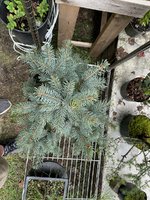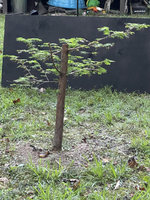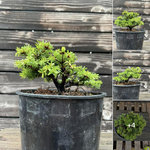El Duderino
Yamadori
I'm hitting hard today. Still a lot of trees to get through.
Next up: Picea pungens 'Baby Blue' aka Baby Blue Spruce. I think I remember reading that these are a dwarf variety of Colorado Spruce.
I bought this tree at a landscape nursery just up the road from my house. It was only $25 and I really liked the foliage color and the trunk was a decent size. I have no plans for this tree yet, other than to go through and deal with the whorls, which seem to be at nearly every node of the trunk. I would love to hear feedback or advice from anyone who has worked with this species. I know @Leo in N E Illinois has a good bit of experience with Spruce in general.
Here's the tree; I haven't done any work on this tree, only watered and fertilized it.
7/9/2021



8/14/2021 - A little bit of growth, I think.




This tree is still pretty supple and can likely take some trunk bends. I really just need to settle on a style. Probably a good candidate for a formal upright. But I won't really know until I can get it cleaned up. Thanks for anyone's advice or feedback on this one. I'm still researching timing of hard pruning vs. regular pruning. I'm holding off on doing anything until I can set a solid plan. Thanks for reading!
Next up: Picea pungens 'Baby Blue' aka Baby Blue Spruce. I think I remember reading that these are a dwarf variety of Colorado Spruce.
I bought this tree at a landscape nursery just up the road from my house. It was only $25 and I really liked the foliage color and the trunk was a decent size. I have no plans for this tree yet, other than to go through and deal with the whorls, which seem to be at nearly every node of the trunk. I would love to hear feedback or advice from anyone who has worked with this species. I know @Leo in N E Illinois has a good bit of experience with Spruce in general.
Here's the tree; I haven't done any work on this tree, only watered and fertilized it.
7/9/2021



8/14/2021 - A little bit of growth, I think.




This tree is still pretty supple and can likely take some trunk bends. I really just need to settle on a style. Probably a good candidate for a formal upright. But I won't really know until I can get it cleaned up. Thanks for anyone's advice or feedback on this one. I'm still researching timing of hard pruning vs. regular pruning. I'm holding off on doing anything until I can set a solid plan. Thanks for reading!































